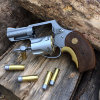USBP379
Member
- Joined
- Dec 27, 2005
- Messages
- 709
Interestingly enough most 380 ammo penetrates to a similar depth than the 165 CD. This is corroborated by info on Hornady's website. There they show 9in in gel.
Pretty much all the good 9mm ammo on the market (HST, Gold Dot, SXT) would likely work just as well. Possibly better.
357 Mag is also probably the better choice and the same might be true of 38 Special +P especially from a 3in barrel.
Pretty much all the good 9mm ammo on the market (HST, Gold Dot, SXT) would likely work just as well. Possibly better.
357 Mag is also probably the better choice and the same might be true of 38 Special +P especially from a 3in barrel.
Last edited:





